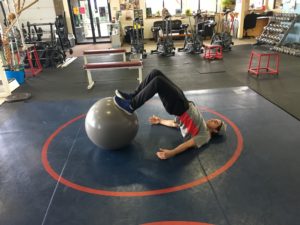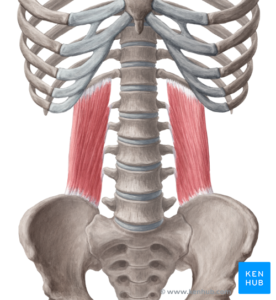To preface this article I will begin by saying that these concepts and principles are best explained in more detail in Mike Boyle’s New Functional Training for Sports, which has been an indispensable resource for me in program design.
Before we dig into how we approach abdominal training, we’ll first look at the anatomy of the abdominal musculature. In order to understand the function of these muscles in the context of sport, we need to understand their structure. Structure leads to function. The muscles we’re focusing on when we think about abdominal training include the rectus abdominis, the six-pack muscle, as well as your internal and external obliques and the transverse abdominis.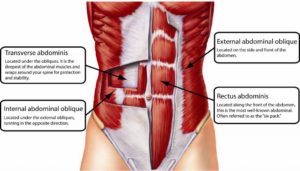 Looking at their placement, it’s quite obvious that they play a large role in what happens in terms of movement of the spine. In traditional anatomy, the function of these muscles is to flex the trunk, twist the trunk, and bend to the side. However, when we consider the job of these muscles while playing sports, it’s actually all about resisting movement. The job of the abdominals while playing sports is stabilization, not movement. Think about a football player bracing himself for a hit, or a soccer player about to take a shot. In both these instances, the abs are active in order to prevent excessive motion and keep the athlete in a stable position. In a strength and conditioning context, our job is to prepare athletes for these situations.
Looking at their placement, it’s quite obvious that they play a large role in what happens in terms of movement of the spine. In traditional anatomy, the function of these muscles is to flex the trunk, twist the trunk, and bend to the side. However, when we consider the job of these muscles while playing sports, it’s actually all about resisting movement. The job of the abdominals while playing sports is stabilization, not movement. Think about a football player bracing himself for a hit, or a soccer player about to take a shot. In both these instances, the abs are active in order to prevent excessive motion and keep the athlete in a stable position. In a strength and conditioning context, our job is to prepare athletes for these situations.
One main job of the anterior abdominal musculature is to prevent excessive extension of the lumbar spine, or low back. When the abs are weak, it’s common for athletes to slip into an extended posture while playing sports, working out, and just in everyday life. This is a common cause of low back pain. If we can teach athletes to turn on their anterior abs effectively, we can reduce this hyperextension and ultimately prevent injuries and improve performance. Put another way, weak abdominals causes the pelvis to tilt anteriorly and cause excessive stress on the low back. It is a key component of lower cross syndrome, which I have talked about previously. How do we begin to use our abs to stabilize are pelvis? There are two exercises, or rather two groups of exercises that are staples of our athletic performance classes:
- The plank
- the ab wheel.
The plank is perhaps the simplest method when learning to resist lumbar extension. This exercise is one of the first drills we use in order to teach kids to engaged their abdominals. In order to fire up the abdominals, we instruct athletes to push into the floor, and think about engaging their glutes, quads, and abdominals. Doing this will instantly make the exercise more difficult and allow the athlete to learn what an isometric abdominal contraction feels like. The other really important key when performing planks is the breath. The diaphragm is a muscle. One of its antagonist muscles is the transverse abdominis, the deepest abdominal muscle. A protagonist-antagonist relationship means that when one muscle is contracted, the other is relaxed and vice-versa. At the bottom of an exhale the diaphragm is maximally relaxed, so the TA is maximally shortened. To take advantage of this during a plank, athletes are instructed to perform long, slow exhales, which helps them to actively engage the deep abdominals.
The ab wheel is the other movement pattern we use to learn to resist extension. However, it is a quite difficult exercise, especially for those who’ve yet to fully grasp the concept of using their abs to resist lumbar extension. So, we start with the stability ball rollout. Think of the stability ball as a giant ab wheel. Starting in a kneeling position with the abs tight and glutes engaged, the athlete rolls forward, leading with the hips. As the athlete rolls out they must keep their abs engaged in order to keep their spine is a solid position. Even if this exercise is easy for the athlete, I like to air on the side of caution to ensure that they can properly control their spine before moving on to the ab wheel.
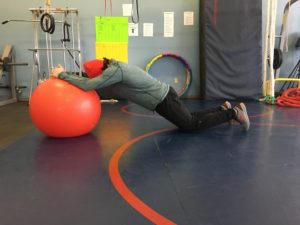
Between the plank and the stability ball rollout, athletes can begin to learn to use their abdominals in order to prevent overuse of their low back muscles. Starting all training programs teaching antiextension will help keep athletes healthy in the long run, and greatly reduce the incidence of low back pain in young athletes.
Stay tuned for part 2 of this three part series on abdominal training, where we’ll focus on antirotation, why it’s important for athletes, and how to train it.
If you’re interested in applying these concepts, our next athletic performance class session is starting Monday, March 5. You can sign up online or give us a call.
Works Cited
“Abdominal Muscles Anatomy.” Abmachinesguide, Ab Machines & Workouts, abmachinesguide.com/abdominal-muscles-anatomy/.
Boyle, Michael. New Functional Training for Sports. Human Kinetics, 2016.




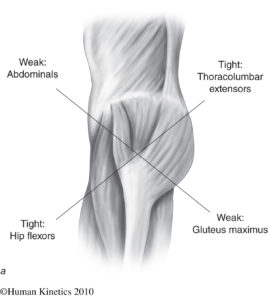
 compensate for these imbalances, your pelvis tilts anteriorly, which creates excessive spinal curvature, also known as hyperlordosis. This syndrome is less formally known as “Donald Duck butt,” due to the appearance of the person’s butt sticking out like Donald Duck. If you think about the lifestyles we lead, this makes perfect sense. We sit at a desk all day, drive our car with our hips in a flexed position, and then go play sports and do exercises that are predominantly performed with our hips in flexion. It is no wonder then, that we are unable to get out of this hip-flexed position when we exercise. Today’s post will focus on strengthening the hip extensors, but it is important to remember that they are just one piece of the puzzle in correcting this fault.
compensate for these imbalances, your pelvis tilts anteriorly, which creates excessive spinal curvature, also known as hyperlordosis. This syndrome is less formally known as “Donald Duck butt,” due to the appearance of the person’s butt sticking out like Donald Duck. If you think about the lifestyles we lead, this makes perfect sense. We sit at a desk all day, drive our car with our hips in a flexed position, and then go play sports and do exercises that are predominantly performed with our hips in flexion. It is no wonder then, that we are unable to get out of this hip-flexed position when we exercise. Today’s post will focus on strengthening the hip extensors, but it is important to remember that they are just one piece of the puzzle in correcting this fault.